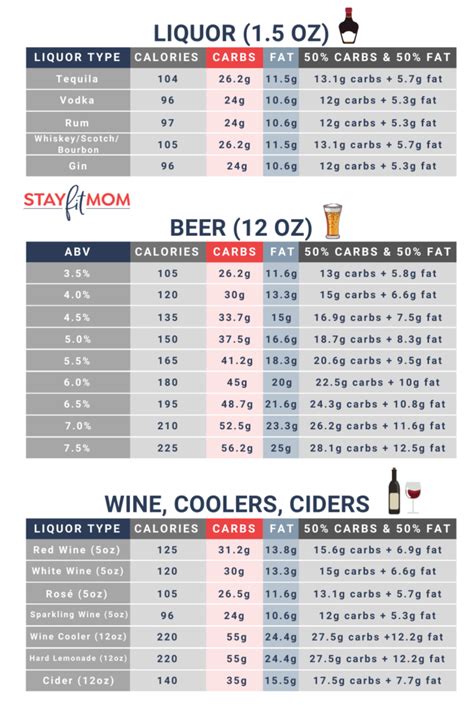Track Your Alcohol Macros and See Amazing Results
Are you trying to achieve your fitness goals but struggling to incorporate alcohol into your lifestyle? Many people believe that enjoying alcoholic beverages automatically derails their progress. However, with mindful tracking and moderation, you can absolutely enjoy the occasional drink without sacrificing your results. This article explores the importance of tracking alcohol macros, explains how to do it effectively, and reveals the amazing results you can achieve by combining a healthy lifestyle with responsible alcohol consumption.
What are Alcohol Macros?
Before we dive into tracking, let's understand what alcohol macros are. Alcohol itself contains 7 calories per gram – significantly higher than carbohydrates and proteins (4 calories per gram) and fats (9 calories per gram). While alcohol doesn't technically fit into the traditional macronutrient categories of protein, carbs, and fat, it still impacts your daily caloric intake and can influence your body composition goals. Understanding the caloric density of your alcoholic beverages is crucial for managing your overall calorie intake.
Why Track Alcohol Macros?
Tracking alcohol macros is essential for several reasons:
- Calorie Management: Alcohol adds significant calories, and consuming too many can easily lead to weight gain, even if you're maintaining a healthy diet otherwise. Tracking helps you stay within your daily caloric goals.
- Macronutrient Balance: While alcohol itself isn't a macronutrient, its calories can displace the intake of protein, carbs, or fats, impacting your muscle growth, energy levels, and overall health. Tracking prevents this imbalance.
- Goal Achievement: Whether you're aiming for weight loss, muscle gain, or simply maintaining a healthy weight, understanding the caloric contribution of alcohol allows you to incorporate it responsibly into your plan without hindering progress.
- Improved Consistency: By consciously tracking, you become more aware of your alcohol consumption, leading to more mindful choices and promoting consistency in your health journey.
How to Track Alcohol Macros Effectively
Tracking alcohol macros doesn't have to be complicated. Here's a simple approach:
- Use a Food Tracking App: Numerous apps (MyFitnessPal, Lose It!, Cronometer, etc.) allow you to log the caloric and macronutrient content of various alcoholic drinks. Many even have pre-programmed options for common drinks.
- Know Your Drink: Familiarize yourself with the calorie count of your favorite alcoholic beverages. The caloric content varies significantly between drinks; a mixed drink often has more calories than a straight shot.
- Pay Attention to Mixers: Mixers like soda, juice, and sugary syrups significantly increase the calorie count of your drink. Opt for low-calorie mixers like sparkling water or diet soda.
- Read Labels Carefully: If you're unsure about the nutritional information of a particular alcoholic beverage, check the label for details. If not listed, you can often find the information online through a quick search.
- Estimate Moderation: Remember, moderation is key. Aim for a responsible amount of alcohol consumption that fits into your overall calorie goals and does not impede your health targets.
What are the best low-calorie alcoholic drinks?
Many people looking to manage their alcohol intake search for lighter options. Some of the lowest-calorie options include:
- Light Beer: These beers often have significantly fewer calories than regular beers.
- Hard Seltzer: Many hard seltzers are lower in calories and carbs compared to other alcoholic beverages.
- Wine (in moderation): A glass of dry wine can be relatively low in calories.
- Spirits with low-calorie mixers: Vodka or gin with a diet soda or sparkling water.
How many calories are in a typical alcoholic drink?
The calorie count of alcoholic drinks varies significantly depending on the type and size of the drink. For example:
- Beer (12 oz): 100-150 calories (varies depending on brand and type)
- Wine (5 oz): 100-125 calories (varies depending on the type of wine)
- Mixed Drinks: Calories can range widely from 100 to 300+ calories depending on the spirits used, mixers, and portion size.
It's crucial to check the label or use a nutrition database to know the specific calorie count of your drinks.
How does tracking alcohol affect weight loss?
Tracking alcohol helps with weight loss by keeping you accountable for your daily calorie intake. It prevents you from unknowingly consuming excess calories from alcoholic beverages, which would hinder your weight loss efforts. By accounting for these calories, you can make informed choices about your food and drink intake to ensure you maintain a calorie deficit necessary for weight loss.
Can I still build muscle while drinking alcohol?
Yes, you can still build muscle while drinking alcohol, but it's generally recommended to moderate your intake. Excessive alcohol consumption can interfere with protein synthesis, hormone production, and overall recovery, potentially hindering muscle growth. However, occasional moderate drinking likely won't significantly impede your muscle-building goals if you're still following a balanced diet and workout routine.
By consistently tracking your alcohol macros and making informed choices, you can enjoy the occasional drink without compromising your fitness goals. Remember, moderation, awareness, and mindful tracking are the keys to success. Don't let the fear of alcohol derail your journey to a healthier, happier you!

